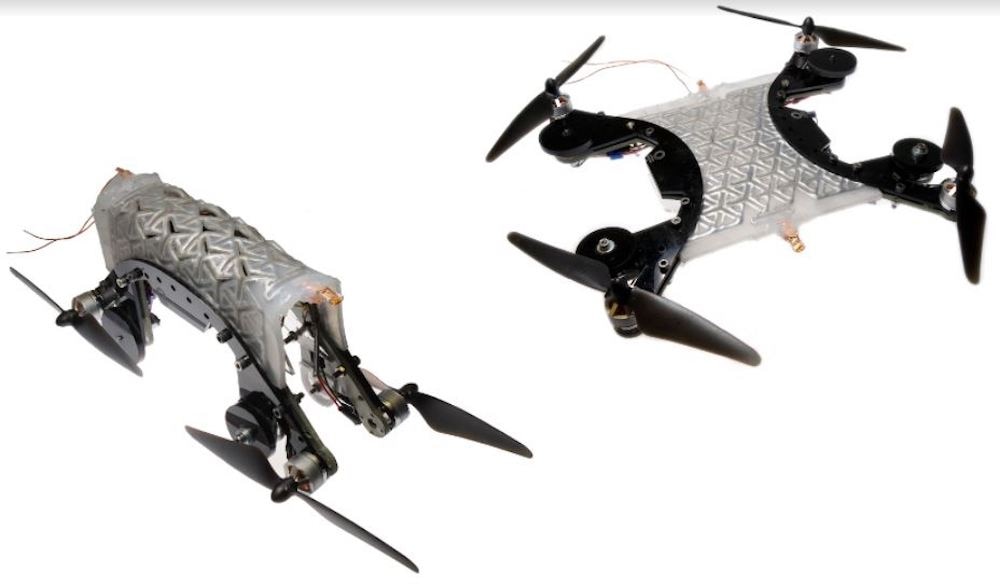Create a free profile to get unlimited access to exclusive videos, sweepstakes, and more!
Transformers, roll (and fly) out! Robotic vehicle uses liquid metal to shapeshift into a plane
These robots are truly more than meets the eye.

When building robots, scientists and engineers often take inspiration from nature. Androids in science fiction take inspiration from the human body, while the incredible but moderately creepy robots built by Boston Dynamics are modeled after dogs. Sometimes, the best way to build a machine which can carry out a task is to look at how evolution achieves that same task.
Michael Bartlett and colleagues from the Department of Mechanical Engineering, Soft Materials and Structures Lab at Virginia Tech are taking that philosophy to its extreme by building malleable soft robots capable of changing their shapes. Using a framework based on kirigami — the Japanese art of cutting paper to achieve complex shapes — and a metal with a low melting point, the team built a slate of robots capable of changing their shape back and forth between configurations. The results of their study were published in the journal Science Robotics.
“We looked at the octopus as something very soft and very functional. We wanted a machine that was highly deformable so that it could occupy different shapes and perform different functions,” Bartlett told SYFY WIRE. “We also wanted it to be able to reverse itself to its initial configuration.”
Crafting a material which could quickly and easily change its shape while still being robust enough to carry a load was a challenge, and materials which could do everything the team wanted were not readily available. So, they had to make them.
Their machines are made of two primary components. The first is a metal alloy with a low melting point of 140 degrees Fahrenheit, the second is the rubber kirigami structure. Each of the robots are constructed by filling the kirigami skeleton with the metal alloy. This combination of materials balances the rigid properties needed to do work while still being malleable enough to quickly change shape.
“It gives us a lot of freedom to occupy different shapes with the same material set,” Bartlett said. “That combination of the metal lattice with the kirigami structure allows us to effectively make any structure we want from cylinders and spheres to saddles with curvature in two directions.”
The paper demonstrates the effects of this material in two different constructions, one meant for land and air, the other designed for use in the water. The first robot begins life as an overland vehicle then, through the introduction of heat, transforms into a drone and flies away. The second begins on the bottom of a water tank, then inflates and swims through the environment collecting hydrogel beads.
The shape change happens rapidly and, importantly, is immediately able to bear weight. The ability to deform without losing structural integrity was achieved through a property of metals known as plastic deformation. This kind of deformation is usually a failure point in traditional materials, but the team turned it into a benefit.
“Most metals, when you stretch them too far, they fail. However, with the materials we chose, when you melt it, the rubber pulls it back into the shape it started as,” Bartlett said.
That means these machines are essentially self-healing. Not only can they change shape intentionally to perform a task, but damage can be reversed through the same process. In experiments, the team intentionally broke their machines and healed them up to ten times.
Machines capable of changing their shape as the need arises have clear implications for search and rescue operations, squeezing into tight places and retaining the ability to return to their original shape. But Bartlett also imagines possibilities closer to home.
“We could ship a swarm of robots in a small box. We pack it tight, then they deploy in whatever shape they need to have, then go back to their original shape for storage,” Bartlett said.
Future versions with variable kirigami designs on the surface and localized heaters could allow for robots which could take a number of different shapes depending on localized choices. All of them would be able to shift back and forth, healing each time. That might lead to a revolution in robotics, but revolution has two distinct connotations, one of which conjures images of The Matrix or Terminator franchises.
“Some people don’t want a machine they can’t destroy. I get that,” Bartlett said.
We get it too, but we’re inclined to think the benefits of more malleable machines outweigh the risks of robot uprising. You can’t have Optimus Prime without optimism.


























